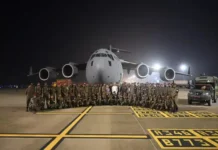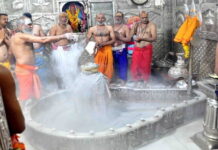MANALI: The construction of one of India’s most challenging and a marvel of engineering motorways — the Rohtang Pass highway tunnel in the Himalayas — is going to finish new strategic heights with an increased length, project engineers said on Sunday.
The 8.8 km-long horseshoe-shaped single-tube two-lane tunnel — the world’s longest motorable tunnel at over 3,000 metre above the sea level, coming up under the 3,978 metre Rohtang Pass in the Pir Panjal range will attain new strategic heights with the increased length, they added.
The Border Roads Organisation (BRO) has been working on the Rs 4,000-crore tunnel project — a dream of former Prime Minister Atal Bihari Vajpayee and named after him posthumously — in collaboration with Afcons, a joint venture with Strabag AG. The tunnel will be inaugurated by Prime Minister Narendra Modi, likely by the end of September.
“Our target date to finish the tunnel is August 31. We are certain to meet the deadline. All its major works will be completed by this date,” BRO Director General Lt. Gen. Harpal Singh told DD News. He reviewed the ongoing construction work on Saturday. This was his second visit to the tunnel this month.
Describing its construction amid very challenging geology and logistics, Singh said the tunnel is situated at an altitude of over 3,000 m with an overburden of approximately two km high mountain. “From this, you can imagine how much pressure is on the tunnel. You can see how complex its support system set up by the engineers is,” he said.
The major geological challenge encountered by the engineers during excavation was the emergence of the Seri ‘nullah’ or rivulet fault zone, which was nearly 600 m long and located 1.7 km from the tunnel face.
The Seri ‘nullah’ flowing on top of the tunnel had almost threatened to derail the project, the BRO chief said. “After the construction of the pilot tunnel, a portion of this (the main) tunnel even caved in,” he said. Describing the project as a major achievement of the BRO, Singh said this is going to be the world’s longest highway tunnel at such an altitude.
Singh inspected the progress related to civil, electrical and mechanical work. He also spent considerable time on the Chandra Bridge at the north portal of the tunnel on which work has progressed at a fast pace.
The tunnel has a maximum overburden of 1,900 metres. Officials involved in the construction told IANS that even after meeting the deadline to complete all major works by August 31, the tunnel with a carriageway width of 10.50 metres, comprising one-metre footpath on both sides, needs a minimum of three more months to make it motorable.
“Still crucial work on two ventilation and control buildings at both portals and several caverns or niches is to be done,” an official, who didn’t want to be quoted, told IANS. Also, the installation of CCTVs at every 250 metres inside the tunnel and construction of one crucial anti-avalanche mechanical structure at the north portal of the tunnel to ensure safety of motorists is yet to be completed.
The entire work will take two-three months more, he added. Chandigarh-based Snow and Avalanche Study Establishment (SASE) has designed mechanical structures to ensure the safety of motorists by countering avalanches on both ends of the tunnel that remain under snow even during peak summer.
Engineers of SASE, a Defence Research and Development Organisation (DRDO) laboratory, said self-escape snow galleries have been erected for the safety of motorists after studying the local dynamics of avalanches like force and velocity. The tunnel has provision of a landline telephone facility at every 150 metres, a fire hydrant every 60 metres along its length and broadcasting system to handle an exigency.
There is also a turning cavern at every 2.2 km and air quality monitoring system after every km. The tunnel will shorten the distance between this Himachal Pradesh tourist resort and Keylong, the headquarters of Lahaul-Spiti, by 46 km, shortening the travel time by nearly three hours.
With the maximum speed limit of 80 km per hour, the tunnel is expected to see traffic of 3,000 cars and 1,500 trucks a day. The most ambitious and expensive undertaking of its kind, the excavation of the tunnel was completed in October 2017.
The tunnel’s foundation stone was laid by United Progressive Alliance (UPA) Chairperson Sonia Gandhi on June 28, 2010, in the Solang Valley near Manali, some 300 km from Chandigarh.
The completion of the Rohtang tunnel is a key element in the Defence Ministry’s attempts to make the entire 475 km-long Manali-Keylong-Leh highway, used by the armed forces to reach forward areas in Ladakh bordering China and Pakistan, motorable almost round the year, officials said. Currently, the movement of armed forces to the forward areas in Ladakh from the Manali side is feasible only from June to mid-November.







